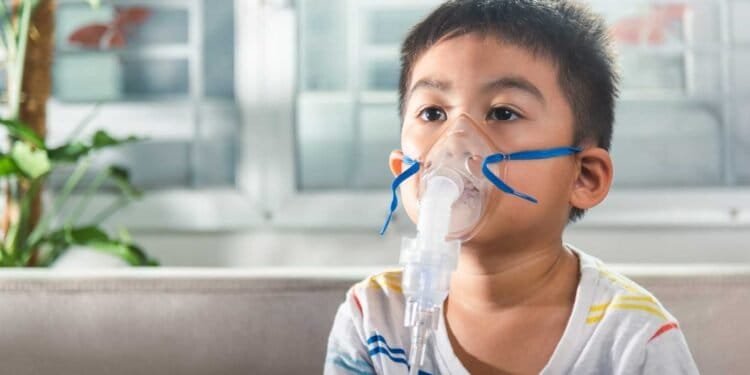Indoor mold is a common household problem that can have serious health implications, particularly for children. According to the Centers for Disease Control and Prevention (CDC), mold exposure can cause a range of respiratory issues, including coughing, wheezing, and asthma attacks. Children who are exposed to mold at an early age are at a higher risk of developing respiratory problems later in life. Therefore, it is essential for parents and caregivers to be aware of the link between indoor mold and childhood respiratory issues.

Mold is a type of fungus that grows in damp, humid environments. It thrives in areas with poor ventilation, such as basements, bathrooms, and kitchens. Mold spores can spread through the air and attach to surfaces, where they can grow and multiply. Exposure to mold can cause a range of symptoms, including nasal congestion, eye irritation, and skin rashes. In severe cases, it can lead to respiratory problems, particularly in children who have weaker immune systems.
Key Takeaways
- Indoor mold can cause a range of respiratory issues in children, including coughing, wheezing, and asthma attacks.
- Mold grows in damp, humid environments with poor ventilation, such as basements, bathrooms, and kitchens.
- To prevent mold-related respiratory issues in children, it is essential to maintain a clean and dry living environment and promptly address any signs of mold growth.
Overview of Childhood Respiratory Issues
Childhood respiratory issues are a major concern for parents and healthcare professionals alike. Respiratory issues can range from mild conditions, such as the common cold, to more severe conditions, such as asthma and pneumonia. These conditions can have a significant impact on a child’s health, leading to missed school days, hospitalizations, and even death.
Prevalence and Impact
Respiratory issues are among the most common health problems affecting children worldwide. According to the World Health Organization (WHO), respiratory infections are the leading cause of death in children under the age of five. In the United States, respiratory illnesses are responsible for millions of visits to the doctor and emergency room each year.
The impact of respiratory issues on children can be significant. Children with respiratory issues often experience difficulty breathing, coughing, wheezing, and chest tightness. These symptoms can interfere with a child’s daily activities, such as playing and sleeping. In severe cases, respiratory issues can lead to hospitalization and even death.
Common Respiratory Conditions in Children
There are several common respiratory conditions that affect children. These include:
-
Asthma: Asthma is a chronic condition that causes inflammation and narrowing of the airways, making it difficult to breathe. It is one of the most common respiratory conditions in children.
-
Bronchiolitis: Bronchiolitis is a viral infection that affects the small airways in the lungs. It is most common in children under the age of two.
-
Pneumonia: Pneumonia is an infection of the lungs that can be caused by bacteria, viruses, or fungi. It can be a serious condition, especially in young children.
-
Common cold: The common cold is a viral infection that affects the upper respiratory tract. It is a common condition in children and can cause symptoms such as coughing, sneezing, and a runny nose.
It is important to note that indoor mold can exacerbate respiratory conditions in children, making them more severe and harder to manage. Parents and healthcare professionals should be aware of the link between indoor mold and childhood respiratory issues and take steps to prevent and address mold growth in the home.
Indoor Mold: Characteristics and Growth Conditions

Types of Indoor Mold
Indoor mold can come in various types and colors, including black, white, green, and brown. Some common types of indoor mold include Aspergillus, Penicillium, Cladosporium, and Alternaria. Each type of mold has its own unique characteristics, and some can be more harmful than others.
Factors Contributing to Mold Growth
Mold requires specific conditions to grow and thrive. The following factors contribute to mold growth in indoor environments:
-
Moisture: Mold needs moisture to grow, and it can grow on any surface that is damp or wet for more than 24-48 hours.
-
Warmth: Mold thrives in warm temperatures, typically between 68-86°F.
-
Darkness: Mold prefers dark environments and can grow in areas with little or no light.
-
Oxygen: Mold needs oxygen to grow and spread.
-
Nutrients: Mold can grow on any organic material, including wood, paper, and fabrics.
It’s important to note that mold growth can occur in any indoor environment, regardless of how clean or well-maintained it is. Therefore, it’s essential to monitor indoor humidity levels and address any water leaks or moisture issues promptly to prevent mold growth.
Linking Mold Exposure to Respiratory Health

Exposure to indoor mold is a common problem that can lead to various health issues, especially in children. There is a growing body of evidence that links mold exposure to respiratory problems in children. This section explores the mechanisms of mold-induced respiratory problems and the evidence from scientific studies.
Mechanisms of Mold-Induced Respiratory Problems
Mold spores can cause respiratory problems in children by triggering an allergic reaction or by irritating the airways. When inhaled, mold spores can cause an allergic reaction in some children, leading to symptoms such as sneezing, runny nose, and itchy eyes. In addition, mold spores can also irritate the airways, causing symptoms such as coughing and wheezing.
Mold can also produce mycotoxins, which are toxic substances that can cause respiratory problems in children. Mycotoxins can cause a range of symptoms, including coughing, wheezing, and shortness of breath. In severe cases, mycotoxin exposure can lead to pulmonary hemorrhage, a life-threatening condition.
Evidence from Scientific Studies
There is a growing body of evidence that links mold exposure to respiratory problems in children. A study conducted by the Institute of Medicine found that exposure to indoor mold is associated with respiratory symptoms, such as coughing, wheezing, and asthma. Another study found that children exposed to mold in their homes were more likely to develop asthma.
In addition, a study conducted by the Centers for Disease Control and Prevention found that exposure to mold in water-damaged buildings is associated with the development of respiratory symptoms, such as coughing and wheezing. The study also found that children exposed to mold in water-damaged buildings were more likely to develop asthma.
Overall, the evidence suggests that exposure to indoor mold can lead to respiratory problems in children. It is important for parents to be aware of the potential health risks associated with mold exposure and to take steps to prevent mold growth in their homes.
Symptoms of Mold-Related Respiratory Issues
Exposure to indoor mold can cause a range of respiratory symptoms in children. These symptoms can be acute or chronic and can vary in severity depending on the extent of the exposure and the child’s sensitivity to mold.
Acute Respiratory Symptoms
Acute respiratory symptoms are those that develop rapidly and typically last for a short period of time. These symptoms may include:
- Coughing
- Wheezing
- Shortness of breath
- Chest tightness
- Runny nose
- Sneezing
- Itchy or watery eyes
- Throat irritation
These symptoms may be more severe in children with asthma or other respiratory conditions.
Chronic Respiratory Symptoms
Chronic respiratory symptoms are those that persist over a long period of time. These symptoms may include:
- Recurrent or persistent cough
- Chronic bronchitis
- Asthma exacerbations
- Sinusitis
- Pneumonia
- Allergic reactions
Children who are exposed to mold on a regular basis may be at increased risk of developing chronic respiratory symptoms.
It is important to note that not all respiratory symptoms are caused by exposure to indoor mold. Other factors, such as viral infections, allergies, and environmental irritants, can also cause similar symptoms. If your child is experiencing respiratory symptoms, it is important to consult a healthcare provider to determine the underlying cause and appropriate treatment.
Diagnosis and Assessment

Medical Evaluation for Mold Exposure
When assessing a child’s respiratory issues, a medical evaluation is crucial to determine if mold exposure is the cause. This evaluation may include a physical exam, lung function tests, and allergy testing. The doctor may also ask about the child’s symptoms and medical history.
If mold exposure is suspected, the doctor may recommend further testing, such as a skin prick test or blood test, to determine if the child has an allergy to mold. In some cases, a chest X-ray or CT scan may be necessary to assess the extent of lung damage.
Environmental Assessments for Mold
In addition to a medical evaluation, an environmental assessment is important to identify the presence of mold in the child’s home or school. This assessment may include a visual inspection, air quality testing, and surface sampling.
If mold is found, it is important to identify the source of the mold and take steps to remove it. This may involve repairing leaks, improving ventilation, and cleaning or removing contaminated materials. In severe cases, professional mold remediation may be necessary.
Overall, a thorough medical and environmental evaluation is necessary to diagnose and address the link between indoor mold and childhood respiratory issues.
Prevention and Mitigation Strategies
Reducing Indoor Humidity
Indoor humidity is a major contributor to mold growth, which can lead to respiratory issues in children. To reduce indoor humidity, it is recommended to use dehumidifiers in damp areas such as basements and bathrooms. Additionally, proper ventilation in the home can also help reduce humidity levels. Using exhaust fans in bathrooms and kitchens can help remove excess moisture from the air. It is also important to fix any leaks or water damage promptly to prevent mold growth.
Mold Remediation Techniques
If mold growth is already present in the home, it is important to address it promptly to prevent further respiratory issues in children. Mold remediation techniques include removing any visible mold growth, fixing the source of moisture, and ensuring proper ventilation in the affected area. It is recommended to hire a professional mold remediation service to ensure proper removal of mold and to prevent further spread of spores.
Overall, taking steps to reduce indoor humidity and promptly addressing any mold growth can help prevent respiratory issues in children. It is important to maintain a clean and dry home environment to promote good respiratory health.
Treatment Options for Affected Children
Pharmacological Interventions
Pharmacological interventions are the most common treatment options for children affected by respiratory issues caused by indoor mold. These interventions include medications such as bronchodilators, corticosteroids, and leukotriene modifiers. Bronchodilators are used to relax the muscles around the airways, allowing for easier breathing. Corticosteroids are used to reduce inflammation in the airways, while leukotriene modifiers are used to block the action of leukotrienes, which are chemicals that cause inflammation.
In severe cases, a child may require hospitalization and intravenous medication, such as epinephrine and aminophylline. These medications are used to open up the airways and improve breathing.
Non-Pharmacological Approaches
Non-pharmacological approaches can also be used to manage respiratory issues caused by indoor mold. These approaches include:
-
Removing the source of mold: The first step in managing respiratory issues caused by indoor mold is to remove the source of the mold. This may involve repairing leaks, improving ventilation, or removing contaminated materials.
-
Air filtration: Air filtration systems can be used to remove mold spores from the air. High-efficiency particulate air (HEPA) filters are particularly effective at removing mold spores.
-
Allergen avoidance: Children with respiratory issues caused by indoor mold should avoid exposure to other allergens, such as pet dander and dust mites. This may involve removing carpets, washing bedding in hot water, and using hypoallergenic pillows and mattress covers.
-
Immunotherapy: Immunotherapy, also known as allergy shots, can be used to desensitize a child’s immune system to mold and other allergens. This involves injecting small amounts of the allergen into the child’s body over a period of time, gradually increasing the dose until the child’s immune system no longer reacts to the allergen.
In conclusion, there are several treatment options available for children affected by respiratory issues caused by indoor mold. Pharmacological interventions can help manage symptoms, while non-pharmacological approaches can help reduce exposure to mold and other allergens. It is important to work with a healthcare provider to determine the best treatment plan for your child.
Public Health and Policy Considerations
Regulations on Indoor Air Quality
In recent years, there has been an increased focus on regulating indoor air quality to protect public health. The Environmental Protection Agency (EPA) has set guidelines for acceptable levels of mold in indoor environments, and some states have implemented their own regulations to ensure healthy indoor air quality.
For example, California has established the California Indoor Air Quality Program, which provides guidelines and resources for improving indoor air quality in homes, schools, and other public buildings. The program recommends regular inspections for mold and other indoor air pollutants, as well as proper ventilation and moisture control.
Other states have implemented similar programs and regulations, highlighting the importance of addressing indoor air quality as a public health issue.
Awareness and Education Initiatives
In addition to regulations, awareness and education initiatives can play a crucial role in preventing childhood respiratory issues related to indoor mold. Parents, caregivers, and teachers should be educated on the signs and symptoms of mold exposure, as well as strategies for preventing and addressing mold growth in homes and schools.
Organizations such as the American Lung Association and the Centers for Disease Control and Prevention (CDC) provide resources and information on indoor air quality and mold prevention. Schools and community centers can also host educational events and workshops to raise awareness and promote healthy indoor environments.
By combining regulations with education and awareness initiatives, we can work towards creating healthier indoor environments for children and reducing the prevalence of respiratory issues related to mold exposure.
Frequently Asked Questions
What are the symptoms of mold exposure in children?
Mold exposure can cause a variety of symptoms in children, including coughing, wheezing, sneezing, runny nose, itchy or watery eyes, and skin rashes. In some cases, children may experience more severe symptoms such as difficulty breathing, chest tightness, and asthma attacks.
How can mold in the home contribute to childhood asthma development?
Exposure to mold in the home has been linked to the development of childhood asthma. Mold spores can irritate the airways and trigger asthma symptoms in children who are already prone to the condition. Long-term exposure to mold may also worsen asthma symptoms and increase the risk of asthma attacks.
Can exposure to mold lead to long-term respiratory issues in children?
Prolonged exposure to mold can lead to long-term respiratory issues in children, including chronic bronchitis and other respiratory infections. In some cases, mold exposure may also contribute to the development of other respiratory conditions such as pulmonary fibrosis.
What are the signs that a child may be suffering from mold toxicity?
Signs that a child may be suffering from mold toxicity include persistent coughing, wheezing, and difficulty breathing. Children may also experience chronic fatigue, headaches, and memory problems. In some cases, mold toxicity may also cause skin rashes, eye irritation, and other allergic reactions.
How is mold exposure diagnosed in children?
Mold exposure is typically diagnosed based on a combination of symptoms and environmental testing. Doctors may perform blood tests or skin tests to determine if a child is allergic to mold. In some cases, imaging tests such as X-rays or CT scans may be used to evaluate the extent of respiratory damage caused by mold exposure.
What steps should be taken to treat respiratory issues linked to mold exposure in children?
Treatment for respiratory issues linked to mold exposure may include medications such as bronchodilators or corticosteroids to alleviate symptoms. In severe cases, hospitalization may be necessary. In addition, it is important to identify and remove the source of mold in the home to prevent further exposure and respiratory issues.














